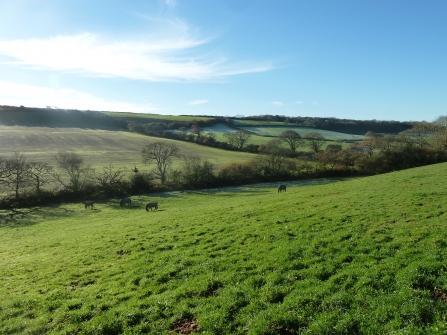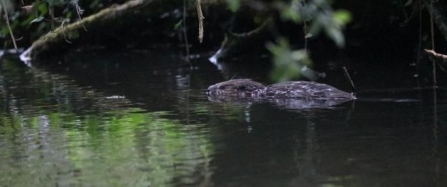Rewilding means very different things to different people. The idea seems to originate from the US, where conservation projects were developed in the 1990s
covering vast tracts of land. These initiatives often involved the reintroduction of large predators that had previously been lost. To some, rewilding must include top predator reintroductions to qualify. This is a big reason for nervousness surrounding rewilding, with people concerned about the safety of domestic pets and livestock. But as Rewilding Britain (a new charity formed after the publication of George Monbiot’s book, Feral) rightly point out, rewilding is not all about wolves and lynx. The trick is to take the principles of the pioneering projects and translate them to suit other places, including areas that are significantly smaller and more heavily populated.
Rewilding - it's not all about wildcats and wolves

The topography of this farmland in Cornwall is similar to successful rewilding projects like in Bavaria. Imagine if beavers were given the space to create incredible wetland habitats here.
We're seeing a surge of interest in rewilding, from all corners of the country. So many people want to see nature not just clinging on, but thriving again, and us with it. That's as much about our oceans as our land. Cornwall has a huge part to play.Specialist Advisor for Rewilding Britain

Nina Constable
The essence of rewilding is the reinstatement or ‘upgrading’ of natural processes. We are unlikely to see wildcats or wolves returning to Cornwall in our
lifetimes, but beaver reintroductions could transform the countryside. These might be rivers allowed to move freely in a floodplain, streams newly dammed by beavers, or grazing animals given the freedom to roam larger areas and behave more naturally than in conventional farming. Ultimately, the aim is to move towards a point where nature can look after itself, without the need for humans to garden it with chainsaws, brushcutters, mowers and flails. You can think of rewilding as a spectrum of natural process function, from low on the left to high on the right. Low would be conventional intensive farmland and high would be an area where wildlife looks after itself. If natural processes can be upgraded at least in part and you move from left to right you are going in the right direction, even if full-on rewilding isn’t possible.
A nerve-racking difference between rewilding and human-led nature conservation management is that there is no defined end point. Traditional nature conservation in the UK is rooted in protecting areas of wildlife habitat that survived as land use around them changed. It was the best we had, but was already highly modified by humans over the centuries. We have come to think of these modified habitats as something we should protect exactly as they are now, rather than how we could make them even better. Another issue is that we are often restricted in the way we manage land, including nature reserves, due to financial necessity. Land management has to follow set rules in order to qualify for agricultural subsidy payments. This does little to reinstate natural processes on nature reserves because the subsidy scheme is designed for land with food production as its primary purpose, not wildlife enhancement. An ecological case of round peg, square hole. Without a cultural memory of natural ecosystem function in the UK, it’s no wonder that we are nervous about the landscape change that results from rewilding. But with 56% of UK species in decline despite our best efforts (a trend mirrored in Cornwall), surely a big shake-up is called for.
Perhaps it's time to leave our ecological comfort zone.
